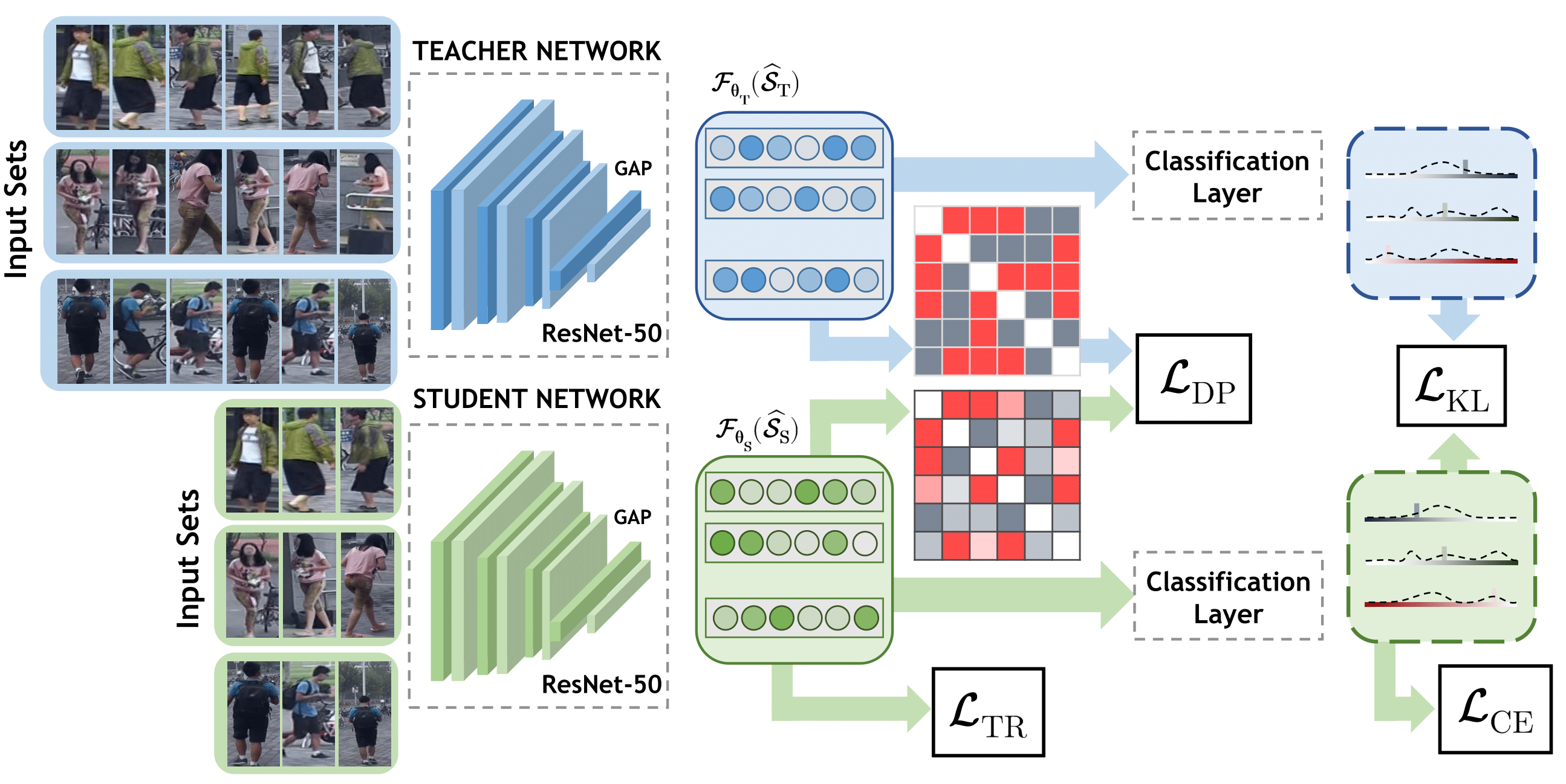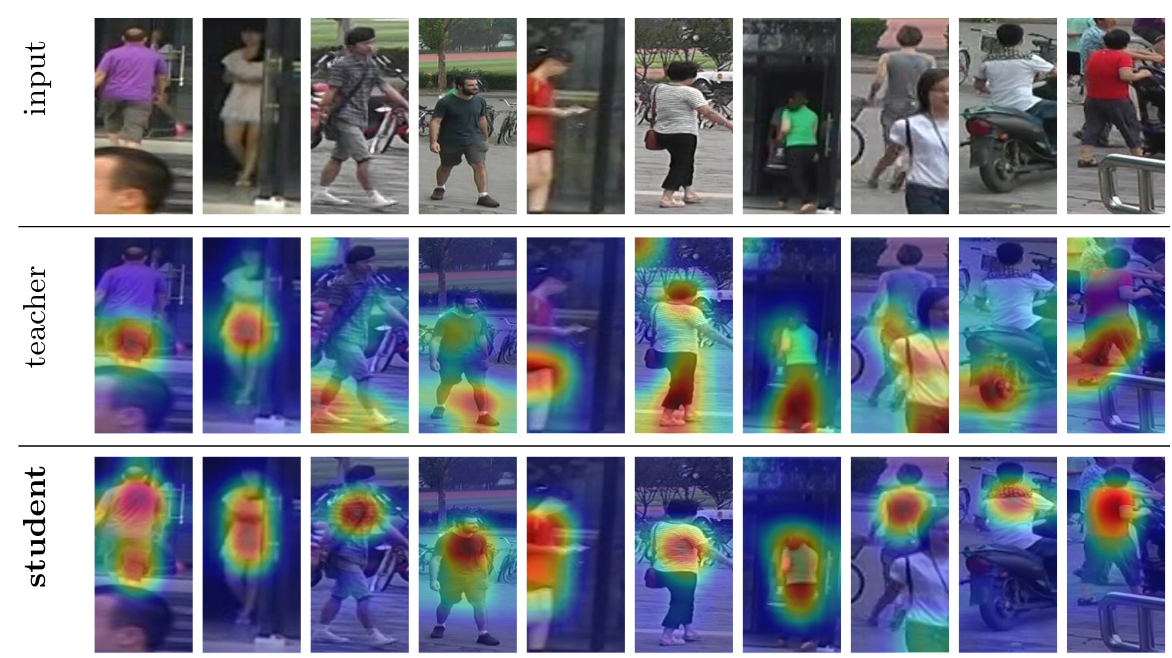This repository contains Pytorch code for the ECCV20 paper "Robust Re-Identification by Multiple Views Knowledge Distillation" [arXiv]
@inproceedings{porrello2020robust,
title={Robust Re-Identification by Multiple Views Knowledge Distillation},
author={Porrello, Angelo and Bergamini, Luca and Calderara, Simone},
booktitle={European Conference on Computer Vision},
pages={93--110},
year={2020},
organization={Springer}
}Tested with Python3.6.8 on Ubuntu (17.04, 18.04).
- Setup an empty pip environment
- Install packages using
pip install -r requirements.txt - Install torch1.3.1 using
pip install torch==1.3.1+cu92 torchvision==0.4.2+cu92 -f https://download.pytorch.org/whl/torch_stable.html - Place datasets in
.datasets/(Please note you may need do request some of them to their respective authors) - Run scripts from
commands.txt
Please note that if you're running the code from Pycharm (or another IDE) you may need to manually set the working path to PROJECT_PATH
- Create the folder
./datasets/mars - Download the dataset from here
- Unzip data and place the two folders inside the MARS [1] folder
- Download metadata from here
- Place them in a folder named
infounder the same path - You should end up with the following structure:
PROJECT_PATH/datasets/mars/
|-- bbox_train/
|-- bbox_test/
|-- info/
First step: the backbone network is trained for the standard Video-To-Video setting. In this stage, each training example comprises of N images drawn from the same tracklet (N=8 by default; you can change it through the argument --num_train_images.
# To train ResNet-50 on MARS (teacher, first step) run:
python ./tools/train_v2v.py mars --backbone resnet50 --num_train_images 8 --p 8 --k 4 --exp_name base_mars_resnet50 --first_milestone 100 --step_milestone 100Second step: we appoint it as the teacher and freeze its parameters. Then, a new network with the role of the student is instantiated. In doing so, we feed N views (i.e. images captured from multiple cameras) as input to the teacher and ask the student to mimic the same outputs from fewer (M=2 by default,--num_student_images) frames.
# To train a ResVKD-50 (student) run:
python ./tools/train_distill.py mars ./logs/base_mars_resnet50 --exp_name distill_mars_resnet50 --p 12 --k 4 --step_milestone 150 --num_epochs 500We provide a bunch of pre-trained checkpoints through two zip files (baseline.zip containing the weights of the teacher networks, distilled.zip the student ones). Therefore, to evaluate ResNet-50 and ResVKD-50 on MARS, proceed as follows:
- Download
baseline.zipfrom here anddistilled.zipfrom here (~4.8 GB) - Unzip the two folders inside the
PROJECT_PATH/logsfolder - Then, you can evaluate both networks using the
eval.pyscript:
python ./tools/eval.py mars ./logs/baseline_public/mars/base_mars_resnet50 --trinet_chk_name chk_endpython ./tools/eval.py mars ./logs/distilled_public/mars/selfdistill/distill_mars_resnet50 --trinet_chk_name chk_di_1You should end up with the following results on MARS (see Tab.1 of the paper for VeRi-776 and Duke-Video-ReID):
| Backbone | top1 I2V | mAP I2V | top1 V2V | mAP V2V |
|---|---|---|---|---|
ResNet-34 |
80.81 | 70.74 | 86.67 | 78.03 |
ResVKD-34 |
82.17 | 73.68 | 87.83 | 79.50 |
ResNet-50 |
82.22 | 73.38 | 87.88 | 81.13 |
ResVKD-50 |
83.89 | 77.27 | 88.74 | 82.22 |
ResNet-101 |
82.78 | 74.94 | 88.59 | 81.66 |
ResVKD-101 |
85.91 | 77.64 | 89.60 | 82.65 |
| Backbone | top1 I2V | mAP I2V | top1 V2V | mAP V2V |
|---|---|---|---|---|
ResNet-50bam |
82.58 | 74.11 | 88.54 | 81.19 |
ResVKD-50bam |
84.34 | 78.13 | 89.39 | 83.07 |
| Backbone | top1 I2V | mAP I2V | top1 V2V | mAP V2V |
|---|---|---|---|---|
DenseNet-121 |
82.68 | 74.34 | 89.75 | 81.93 |
DenseVKD-121 |
84.04 | 77.09 | 89.80 | 82.84 |
| Backbone | top1 I2V | mAP I2V | top1 V2V | mAP V2V |
|---|---|---|---|---|
MobileNet-V2 |
78.64 | 67.94 | 85.96 | 77.10 |
MobileVKD-V2 |
83.33 | 73.95 | 88.13 | 79.62 |
As discussed in the main paper, we have leveraged GradCam [2] to highlight the input regions that have been considered paramount for predicting the identity. We have performed the same analysis for the teacher network as well as for the student one: as can be seen, the latter pays more attention to the subject of interest compared to its teacher.
You can draw the heatmaps with the following command:
python -u ./tools/save_heatmaps.py mars <path-to-teacher-net> --chk_net1 <teacher-checkpoint-name> <path-to-student-net> --chk_net2 <student-checkpoint-name> --dest_path <output-dir>- Zheng, L., Bie, Z., Sun, Y., Wang, J., Su, C., Wang, S., Tian, Q.: Mars: A video benchmark for large-scale person re-identification. In: European Conference on Computer Vision (2016)
- Selvaraju, R. R., Cogswell, M., Das, A., Vedantam, R., Parikh, D., & Batra, D. (2017). Grad-cam: Visual explanations from deep networks via gradient-based localization. In Proceedings of the IEEE international conference on computer vision (pp. 618-626).


